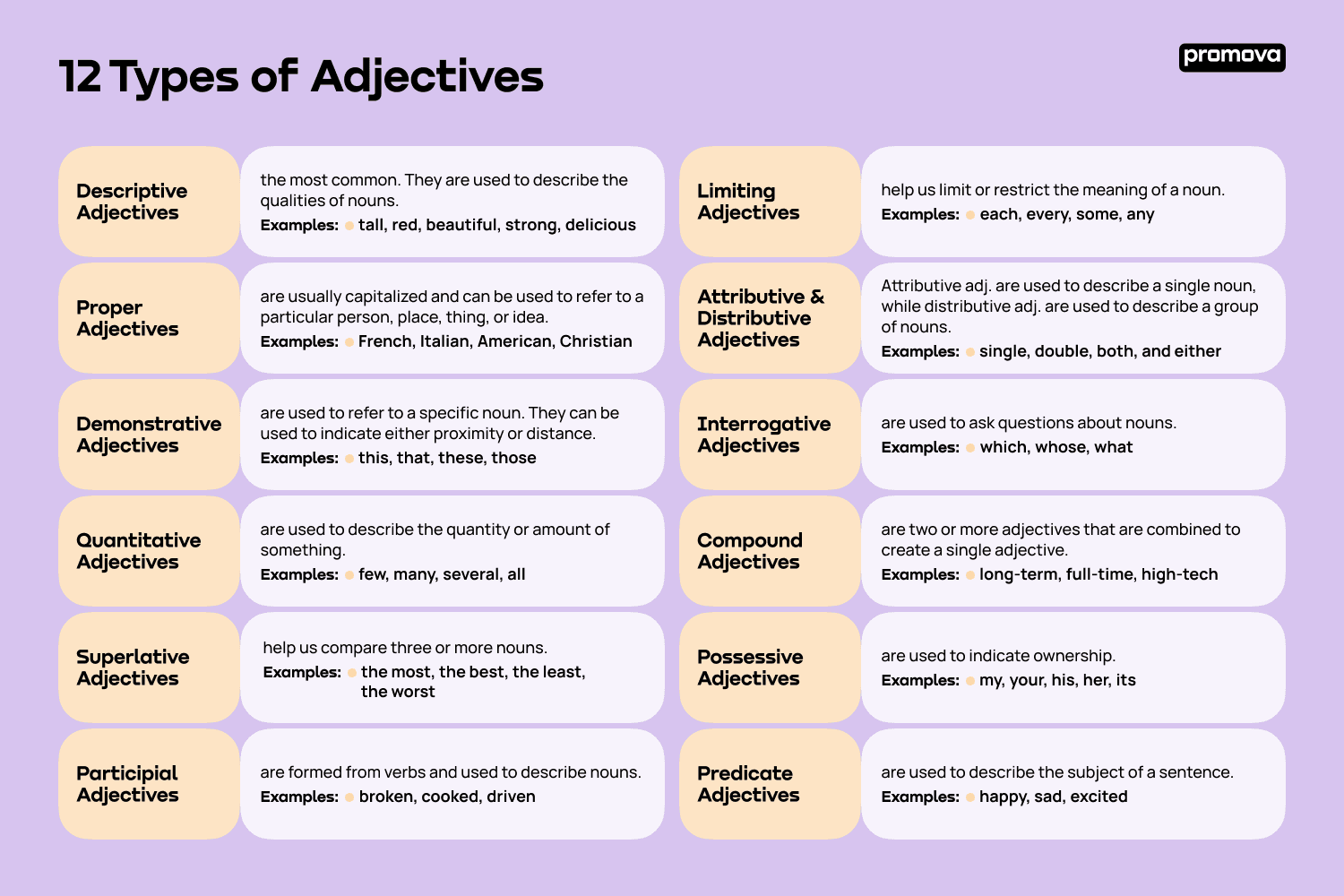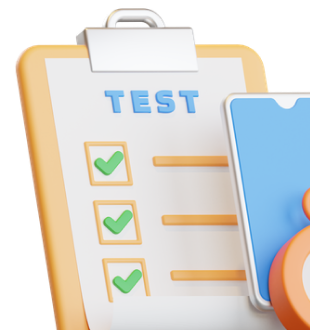Types of Adjectives in English
Contents
Adjectives can be used in many ways to make sentences more interesting and provide detail. This reference will answer how many different types of adjectives exist and help provide useful examples.
12 Types of Adjectives and Examples
English has twelve main types of adjectives. These are:
1. Descriptive Adjectives
Descriptive adjectives are the most common. They are used to describe the qualities of nouns. Examples of descriptive adjectives include tall, red, beautiful, strong, and delicious.
2. Proper Adjectives
Proper adjectives are derived from proper nouns. They are usually capitalized and can be used to refer to a particular person, place, thing, or idea. Examples of proper adjectives include French, Italian, American, and Christian.
3. Demonstrative Adjectives
Demonstrative adjectives are used to refer to a specific noun. They can be used to indicate either proximity or distance. Examples of demonstrative adjectives include this, that, these, and those.
4. Quantitative Adjectives
Quantitative adjectives are used to describe the quantity or amount of something. Examples of quantitative adjectives include few, many, several, and all.
5. Superlative Adjectives
Superlative adjectives help us compare three or more nouns. Examples of superlative adjectives include the most, the best, the least, and the worst.
6. Participial Adjectives
Participial adjectives are formed from verbs and used to describe nouns. Examples of participial adjectives include broken, cooked, and driven.
7. Limiting Adjectives
Limiting adjectives help us limit or restrict the meaning of a noun. Examples of limiting adjectives include each, every, some, and any.
8. Attributive and Distributive Adjectives
Attributive and distributive adjectives are used to describe nouns in different ways. Attributive adjectives are used to simply describe a noun, while distributive adjectives are used to describe a group of nouns. Examples of distributive adjectives include each, every, either, neither, any, and both. Examples of attributive adjectives include beautiful, tall, red.
9. Interrogative Adjectives
Interrogative adjectives are used to ask questions about nouns. Examples of interrogative adjectives include which, whose, and what.
10. Compound Adjectives
Compound adjectives are two or more adjectives that are combined to create a single adjective. Examples of compound adjectives include long-term, full-time, and high-tech.
11. Possessive Adjectives
Possessive adjectives are used to indicate ownership. Examples of possessive adjectives include my, your, his, her, and its.
12. Predicate Adjectives
Predicate adjectives are used to describe the subject of a sentence. Examples of predicate adjectives include happy, sad, and excited.
Now, let's look at all types of adjectives in more detail:
7
Descriptive Adjectives
Descriptive adjectives help describe the qualities of nouns and can be used to make sentences more interesting and provide detail.
They can be divided into three main categories: physical adjectives, emotional adjectives, and mental adjectives:
- Physical adjectives describe physical characteristics, such as size, shape, and color. Examples of physical adjectives include tall, round, and blue.
- Emotional adjectives describe emotions, such as happiness, sadness, and anger. Examples of emotional adjectives include happy, sad, and angry.
- Mental adjectives describe mental characteristics, such as intelligence, knowledge, and wisdom. Examples of mental adjectives include clever, knowledgeable, and wise.
Descriptive adjectives can also be divided into absolute and relative:
- Absolute adjectives describe a noun in an absolute way without making any comparisons. Examples of absolute adjectives include old, young, and rich.
- Relative adjectives describe a noun relatively, comparing two or more nouns. Examples of relative adjectives include bigger, smaller, and happier.
Proper Adjectives
Proper adjectives come from proper nouns. They are usually capitalized and can be used to refer to a particular person, place, thing, or idea. Proper adjectives are formed by adding an -ian or -esque suffix to the end of a proper noun.
For example, the proper noun "Canada" can become the proper adjective "Canadian", and the proper noun "Rome" can become the proper adjective "Roman". Proper adjectives can also be formed by affixing a proper noun. For example, the proper noun "France" can become the proper adjective "Franco-," and the proper noun "London" can become the proper adjective "London-."
Proper adjectives can be used to describe a wide variety of things. They can refer to specific places, such as the Canadian Rockies, the Roman Colosseum, and the Franco-Italian Alps. They can also refer to specific people, such as the French artist Monet, the British actor Lawrence Olivier, and the American ex-president Obama.
Demonstrative Adjectives
Demonstrative adjectives are used to refer to a specific noun. They can be used to indicate either proximity or distance. The demonstrative adjectives "this" and "these" indicate proximity.
For example, "This shirt is too small." or "These shoes are too tight." The demonstrative adjectives "that" and "those" are used to indicate distance. For example, "That shirt looks nice." or "Those shoes look comfortable."
Demonstrative adjectives can refer to a specific noun without actually naming it. For example, "This is a great movie." or "That was an amazing concert." In addition, they can emphasize a particular point. For example, "This is the best restaurant in town" or "That was the most memorable day of my life."
Quantitative Adjectives
Quantitative adjectives describe the quantity or amount of something. They are used to indicate how much of something there is or how many of something there are.
Quantitative adjectives can be divided into two categories:
- Indefinite adjectives that describe an unspecified amount or number. Examples of indefinite adjectives include few, many, several, and any.
- Definite adjectives that describe a specific amount or number. Examples of definite adjectives include one, two, three, and four.
From here, we can divide them into two more categories:
- Cardinal adjectives that describe the quantity or amount of something. Examples of cardinal adjectives include few, many, several, and all.
- Ordinal adjectives that describe the order of something. Examples of ordinal adjectives include first, second, third, and fourth.
Superlative Adjectives
Superlative adjectives help us compare three or more nouns. They are used to indicate which one is the most or the least of all the nouns being compared.
Superlative adjectives can be divided into two categories:
- Positive superlatives that indicate which one is the most or the best of all the nouns being compared. Examples of positive superlatives include the most, the best, the greatest, and the finest.
- Negative superlatives that indicate which one is the least or the worst of all the nouns being compared. Examples of negative superlatives include the least, the worst, the smallest, and the weakest.
Superlative adjectives often help us emphasize a particular point. For example, "This is the most important decision of my life" or "He is the best candidate for the job."
Participial Adjectives
Participial adjectives are formed from verbs and used to describe nouns. They are formed by adding the -ing or -ed suffix to the end of a verb.
Participial adjectives are used to describe the state, condition, or action of a noun. For example, if a noun is "broken," the participial adjective "broken" can be used to describe it. If a noun is "cooked," the participial adjective "cooked" can be used to describe it. If a noun is "driven," the participial adjective "driven" can be used to describe it.
Participial adjectives also help us emphasize points. For example, "His broken heart was too much to bear," or "The cooked food was delicious," or "The driven car was fast."
Limiting Adjectives
Limiting adjectives help us limit or restrict the meaning of a noun. They are used to specify which one of several nouns is being referred to.
They help us limit the meaning of a sentence with words such as some, any, several, and many. They can also refer to a specific noun with words like this, that, these, and those.
Limiting adjectives often help us specify who or what we refer to. For example, "Some of the books were missing," or "Any of the students can answer the question," or "These books are my favorites."
Attributive and Distributive Adjectives
Attributive and distributive adjectives are used to describe nouns in different ways. Attributive adjectives are used to describe a single noun directly, while distributive adjectives are used to describe a group of nouns.
Attributive adjectives are just attributes of a single noun. Examples include tall, red, and beautiful. Distributive adjectives are used to describe a group of nouns. Examples of distributive adjectives include both, either, neither, and any.
Distributive adjectives can also help us specify meaning. For example, "Both of the books were interesting," or "Either of the students can answer the question," or "Neither of the movies was good."
Interrogative Adjectives
Interrogative adjectives are used to ask questions about nouns. They help ask which one of several nouns is being referred to.
Examples of interrogative adjectives include what kind, which color, and whose. We can also ask questions about the quantity of a noun. Examples include which one, how many, and how much.
In a sentence, we would ask, "Whose books did you take?" or "Which color do you prefer?"
Compound Adjectives
Compound adjectives are two or more adjectives that are combined to create a single adjective. They are used to provide more detail about a noun and make sentences more interesting.
Compound adjectives can be divided into two types of adjectives:
- Hyphenated adjectives that are always combined with a hyphen. Examples include long-term, full-time, and high-tech.
- Non-hyphenated adjectives that can be spelled with or without the hyphen. Examples include well-known and hardworking.
In a sentence, we would say, "He is a long-term employee," or "She is a well-known actress," or "It is a high-tech device."
Possessive Adjectives
Possessive adjectives are used to indicate ownership. They are used to show who or what something belongs to.
Possessives can be divided into two adjective types:
- Singular possessive adjectives indicate that something belongs to a single person or thing. Examples of singular possessive adjectives include my, your, his, and its.
- Plural possessive adjectives indicate that something belongs to more than one person or thing. Examples of plural possessive adjectives include our, their, and yours.
Possessive adjectives often come up in sentences. For example, "This is my house," or "That is their car," or "This is his laptop."
Predicate Adjectives
Predicate adjectives are adjectives that describe the subject of a sentence. They are usually placed after a linking verb such as be, seem, or become.
Examples of predicate adjectives include happy, sad, excited, and bored. Predicate adjectives come up in all sorts of sentences. For example, "He was angry," or "She seemed tired," or "The food tasted delicious."

Summary
Now you understand all types of adjectives and their role in the English language. The types of adjectives you learned include descriptive adjectives, comparative adjectives, superlative adjectives, demonstrative adjectives, interrogative adjectives, indefinite adjectives, possessive adjectives, and predicate adjectives. Each type of adjective has its own purpose, and over time, you will learn to use them effortlessly in your speech.



Comments